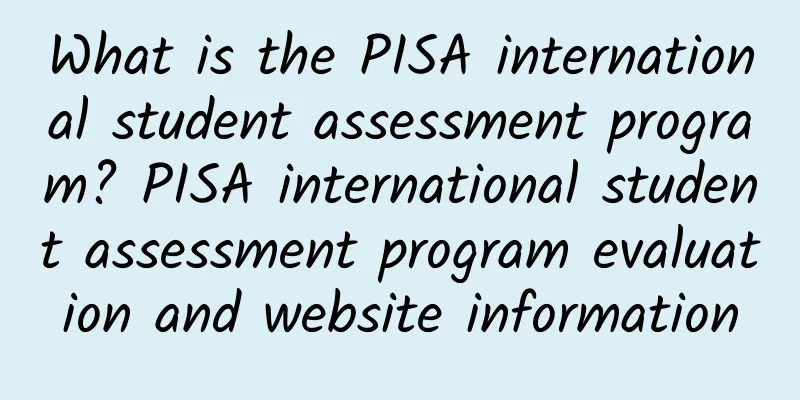What is the PISA international student assessment program? PISA international student assessment program evaluation and website information

|
What is the PISA website? The Programme for International Student Assessment (PISA) is one of the most influential international student learning assessment programs in the world. It was planned by the Organization for Economic Cooperation and Development and started in 2000. It is held every three years and mainly compares the educational levels around the world, aiming to develop educational methods and results. Website: www.pisa.oecd.org PISA International Student Assessment Program: A Weathervane of Global Education In today's era of rapid globalization, countries are paying more and more attention to the quality of education. How to measure the academic performance and learning outcomes of students in different countries and regions? How to provide a reference for educational policy making through scientific evaluation methods? The answers to these questions can be found in the PISA international student ability assessment program. PISA (Programme for International Student Assessment) is one of the most influential international student learning assessment programs in the world. This assessment program, planned and led by the Organization for Economic Cooperation and Development (OECD), has been held every three years since 2000. It aims to comprehensively understand the performance and differences of education systems around the world by assessing the three core literacy of 15-year-old students in reading, mathematics and science. As a global research project driven by data, PISA not only provides valuable reference information for governments and education decision-makers, but also helps the public to have a deeper understanding of the current situation and challenges of education quality and equity. In addition, it has also become an important indicator of global education reform and development. The following is a detailed introduction to the PISA international student competency assessment program: 1. PISA’s core objectives and assessment frameworkThe core goal of PISA is to assess the ability of 15-year-old students in the three major areas of reading, mathematics and science through standardized tests and questionnaires, while paying attention to the application value of these abilities in real life. The selection of this age group is based on the following considerations: 15 years old is usually the time when compulsory education ends, which can reflect the knowledge and skills acquired by students throughout the basic education stage; at the same time, this is also a key turning point in life, marking that students are about to enter higher education or the workplace. The PISA assessment framework revolves around three main dimensions:
It is worth noting that each PISA test will set a focus area for assessment, for example, the focus in 2018 was reading literacy, while the focus in 2021 was mathematics literacy. This rotation mechanism ensures that all abilities are given adequate attention, while also allowing participating countries to explore the educational effectiveness of specific areas in more depth. 2. PISA Implementation Process and MethodologyThe implementation process of PISA is rigorous and complex, involving multiple stages of work. From sample selection to data analysis, every link strives to be scientific and fair. First, in terms of sample selection, PISA uses random sampling to select representative schools and student groups from each participating country. Normally, each country needs to select at least 4,500 students for testing to ensure that the results are statistically reliable. Secondly, the content design of the PISA test follows strict standards. The test questions not only cover the assessment of basic knowledge, but also focus on testing students' high-order thinking ability and interdisciplinary comprehensive application ability. In order to adapt to students from different cultural backgrounds, all test questions have been translated and calibrated to ensure their applicability and consistency worldwide. Finally, in addition to standardized tests, PISA also collects a lot of background information through questionnaires, including data on students' family environment, study habits, school resources, etc. This additional information provides an important supplementary perspective for interpreting test results. 3. Impact and Significance of PISAThe impact of PISA goes far beyond simple test score rankings. It provides an objective comparative benchmark for national education systems, enabling policymakers to better identify their own strengths and weaknesses and learn from the successful experiences of other countries. For example, Finland has attracted much attention for its excellent performance in previous PISA tests and has become a model for global education reform. Finland's experience shows that reducing class time, focusing on teacher professional development and creating a positive learning atmosphere are key factors in improving education quality. On the other hand, PISA also reveals common challenges faced by many countries, such as urban-rural gaps, gender differences and the performance of immigrant students. These problems have prompted countries to review their existing education policies and take targeted measures to improve them. In addition, the results of PISA have also triggered a wide public discussion on educational equity, reminding us that it is not enough to focus on average scores, but also to ensure that every student has an equal opportunity to realize their potential. IV. PISA official website and its resourcesIf you want to learn more about PISA, you can visit its official website: www.pisa.oecd.org . The website provides a wealth of resources, including test reports from previous years, data analysis tools, and related research articles. Through this platform, you can download detailed statistics, view charts comparing performance across countries, and even find case studies on specific topics. These resources are an invaluable treasure trove for educators, researchers, and anyone interested in global education trends. 5. Future Prospects of PISAWith the advancement of technology and changes in social needs, PISA is also constantly adjusting and improving its own assessment system. For example, in recent years, PISA has begun to pay more attention to the assessment of students' "global competence", that is, their ability to communicate and cooperate effectively in a multicultural context. In addition, in the face of the advent of the digital age, PISA is also actively exploring how to introduce computerized tests into the assessment process in order to more accurately capture students' performance in a digital environment. This attitude of keeping pace with the times has kept PISA at the forefront of the global education assessment field. In short, the PISA international student assessment program is not only an important tool for measuring the quality of education, but also a driving force for promoting global educational progress. Through continuous efforts and innovation, PISA will continue to contribute to building a more equitable, efficient and inclusive education system. |
>>: What is Algolia like? Algolia review and website information
Recommend
How is Agoda? Agoda reviews and website information
What is Agoda? Agoda is a well-known online hotel ...
The best pickled cucumber recipe
Pickled cucumbers are a kind of dish that many pe...
The effects and benefits of watermelon seeds
People usually like to eat some melon seeds when ...
Five-grain intestine-moistening porridge
Are you familiar with the effects of five-grain i...
How is Vietnam International Law Firm? Vietnam International Law Firm Reviews and Website Information
What is the website of Vietnam International Law F...
How is the National Bank of Kuwait? Reviews and website information of the National Bank of Kuwait
What is the website of National Bank of Kuwait? Na...
Flower leaf green radish picture potted flower leaf green radish cultivation skills
You must be familiar with the green radish, which...
The practice and efficacy of longan and wolfberry porridge
Longan is a fruit with high nutritional value. It...
The efficacy and function of stewed oranges
Oranges are delicious fruits that are available i...
Pumpkin health recipes How to cook pumpkin most effectively
There are many kinds of pumpkin health recipes, s...
The benefits of mutton soup
When it comes to mutton soup, people will say tha...
What can't be eaten with celery?
Celery belongs to the Umbelliferae family. There ...
The harms and benefits of chewing betel nut
Betel nut is the most important specialty of sout...
The efficacy and function of yellow chives and the key points of cultivation of yellow chives
Do you like flowers? Do you know what the yellow ...
Is goat milk better or cow milk? Comparison of the effects of goat milk and cow milk
Everyone is familiar with cow's milk, which i...









